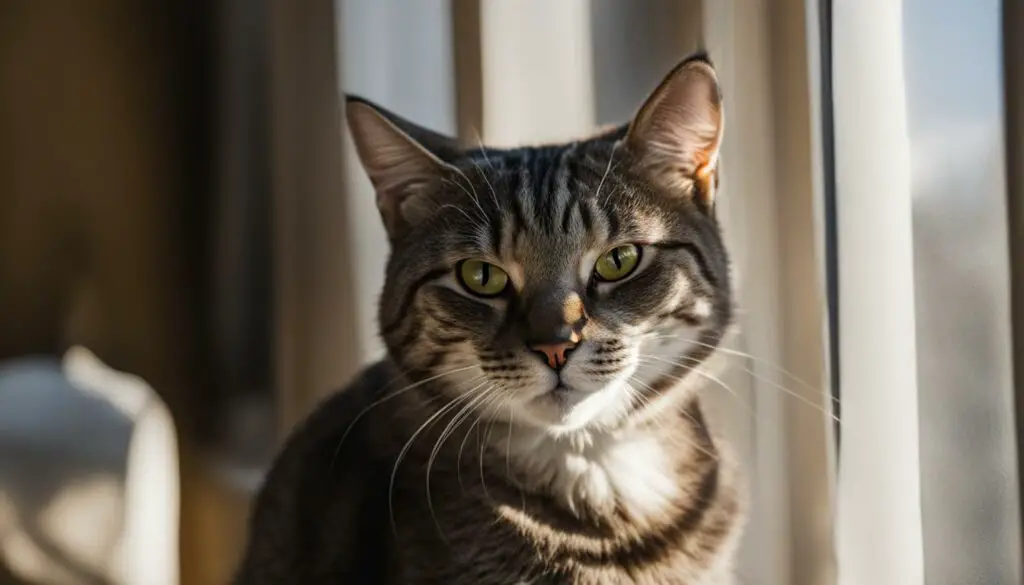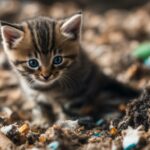As a cat owner, I’ve often wondered about my feline friend’s peculiar behavior. One question that has crossed my mind is whether it’s safe for cats to lick plastic. After doing some research, I’ve discovered some fascinating information that I’d like to share with you.
Cats are known for their curious nature, and sometimes, that curiosity leads them to engage in behaviors that may pose potential risks. Licking plastic is one such behavior, and it can be a cause for concern. Ingesting plastic can lead to serious health issues for cats, including intestinal blockage or the need for emergency surgery. Some cat breeds, like Burmese and Siamese, are more prone to developing this behavior, but it can occur in any cat. It’s important for cat owners to be aware of the potential hazards and take preventative measures to ensure their cat’s safety.
Understanding the causes of this behavior is key to addressing it effectively. Pica, the act of eating non-food items like plastic, can be influenced by genetic factors, underlying health conditions, and environmental factors. Cats may engage in plastic licking to fulfill their urge to chew, mimic hunting behavior, or seek attention. Stress, boredom, and lack of enrichment can also contribute to this behavior.
In this article, I will delve deeper into the risks of cats licking plastic, how to identify the causes, and the measures you can take to prevent this behavior. I will also discuss the importance of seeking veterinary advice and creating an enriched environment for your cat. By understanding your feline friend’s behavior and taking proactive steps, you can ensure their health and happiness.
Key Takeaways:
- Plastic licking behavior in cats can pose serious health risks, such as intestinal blockage.
- Certain cat breeds, like Burmese and Siamese, are more prone to engaging in plastic licking.
- Pica, the act of eating non-food items like plastic, can be influenced by genetic factors, health conditions, and environmental factors.
- Cat owners should be aware of the potential hazards and take preventative measures to ensure their cat’s safety.
- Creating a stimulating and enriched environment, seeking veterinary advice, and understanding cat behavior can help address and prevent plastic licking behavior.
Understanding the Causes of Pica in Cats
Cats engaging in the behavior of licking plastic may be exhibiting a condition known as pica. Pica is characterized by the consumption of non-food items such as plastic. This behavior can be influenced by a combination of genetic factors, health issues, and environmental factors. Some cat breeds, like Siamese and Burmese, are more predisposed to developing pica. Additionally, underlying health conditions such as inflammatory bowel disease or intestinal blockage can contribute to this behavior. Environmental factors like stress, boredom, or lack of enrichment can also lead to cats engaging in pica. Understanding these causes can help cat owners address the issue and ensure the well-being of their feline companions.
In order to fully comprehend the reasons behind a cat’s plastic licking behavior, it is important to consider genetic and health factors. Different cat breeds have varying predispositions to pica, with Siamese and Burmese cats being more prone to the behavior. Additionally, certain health conditions like inflammatory bowel disease or intestinal blockage can contribute to pica in cats. These factors can influence a cat’s inclination to engage in plastic licking behavior. Furthermore, environmental factors play a significant role in this behavior. Stress, boredom, or a lack of environmental enrichment can increase a cat’s likelihood of engaging in pica. By understanding the causes, cat owners can take appropriate measures to address this behavior and maintain their cat’s health and safety.
Cat behavior, including plastic licking, can be influenced by a combination of genetic factors, health issues, and environmental conditions. Certain cat breeds, like Siamese and Burmese, have a higher predisposition to developing pica. Underlying health conditions, such as inflammatory bowel disease or intestinal blockage, can contribute to this behavior. Environmental factors, such as stress or a lack of mental and physical stimulation, can also lead to cats engaging in pica. By understanding these causes, cat owners can better identify and address the plastic licking behavior in their feline companions. It is important to create an enriched environment and seek veterinary advice to ensure the well-being of the cat and prevent any potential health risks associated with plastic ingestion.
| Cause | Description |
|---|---|
| Genetic Factors | Certain cat breeds, like Siamese and Burmese, are more prone to developing pica. |
| Health Issues | Underlying conditions such as inflammatory bowel disease or intestinal blockage can contribute to plastic licking behavior. |
| Environmental Factors | Stress, boredom, or lack of mental and physical stimulation can lead to cats engaging in pica. |
Identifying the Risks of Cats Licking Plastic
Cats that lick plastic face various risks that can impact their health and wellbeing. It is important for cat owners to be aware of these dangers and take necessary precautions to ensure their pet’s safety.
One of the primary risks of cats licking plastic is the potential for intestinal blockage. When cats ingest plastic, it can get lodged in their digestive system, leading to a blockage that may require emergency surgery to remove. This can be a life-threatening condition if not promptly addressed.
Chewing on plastic wires also poses a significant danger to cats. This behavior can result in burns or even electrocution if the wires are connected to a power source. It is crucial to keep plastic-coated cords out of your cat’s reach to prevent accidents and injuries.
Furthermore, plastic bags and other small objects can pose choking hazards or cause gastrointestinal obstructions. Cats may accidentally swallow these items while licking or chewing on them, putting them at risk of serious health complications. It is important to keep plastic bags and other small objects securely stored away to prevent such incidents.
Table: Risks of Cats Licking Plastic
| Risks | Consequences |
|---|---|
| Intestinal blockage | Potential need for emergency surgery |
| Chewing on plastic wires | Burns or electrocution |
| Choking hazards | Potential for asphyxiation |
| Gastrointestinal obstructions | Potential for surgery or other medical interventions |
By understanding the risks and hazards associated with cats licking plastic, cat owners can take appropriate measures to minimize these dangers and keep their beloved pets safe. Prevention is key in providing a secure environment for cats, and proactive measures can help mitigate the potential risks.
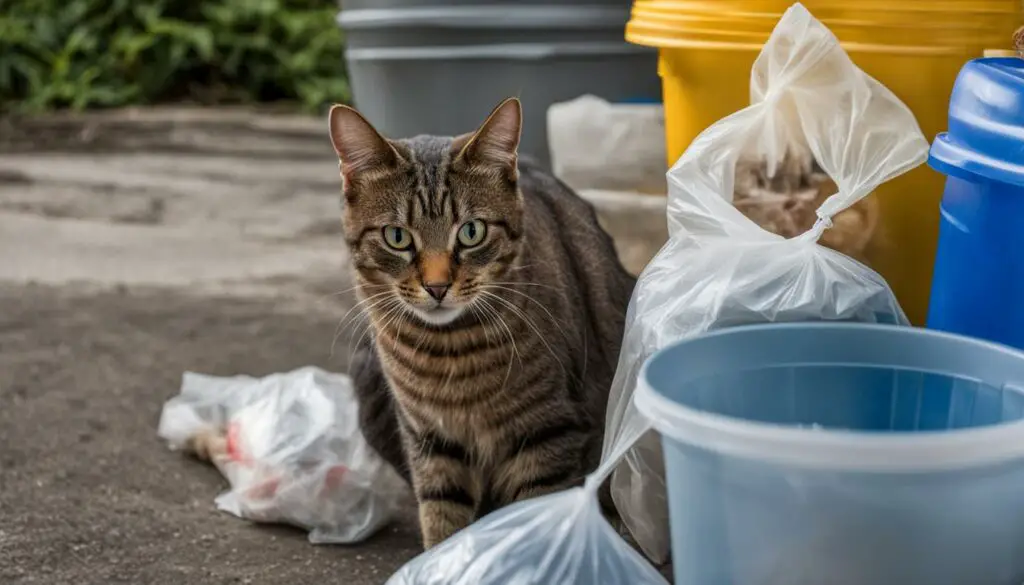
Preventative Measures for Cats with Plastic Licking Behavior
Cat owners can take proactive steps to discourage cats from engaging in plastic licking behavior. By providing a stimulating and enriched environment, owners can help reduce boredom, stress, and the likelihood of cats resorting to pica.
Creating a Stimulating Environment
Offering a variety of toys and playtime can keep cats mentally and physically engaged, diverting their attention from plastic objects. Interactive toys like puzzle feeders or treat-dispensing toys can provide mental stimulation and satisfy their natural hunting instincts. Additionally, incorporating vertical spaces, such as cat trees or shelves, and hiding spots can enrich their environment and offer new exploration opportunities.
Nutrition and Health Maintenance
Ensuring that cats receive a well-balanced and nutritious diet is crucial in preventing pica. Consulting with a veterinarian can help determine the appropriate diet and any necessary supplements to meet a cat’s specific nutritional needs. It is also important to address any underlying health issues that may contribute to pica, such as inflammatory bowel disease or dental problems. Regular veterinary check-ups and prompt treatment of any medical conditions are essential in maintaining a cat’s overall health and well-being.
Removing Access to Plastic Objects
To deter cats from engaging in plastic licking behavior, it is important to remove access to plastic objects. This may involve storing plastic bags out of reach, securing cords with plastic coating, or placing barriers to prevent access to certain areas. Providing safe alternatives to satisfy their chewing needs, such as chew toys made of cat-friendly materials, can redirect their attention away from plastic objects. Additionally, applying bitter-tasting sprays on plastic items can discourage cats from chewing on them.
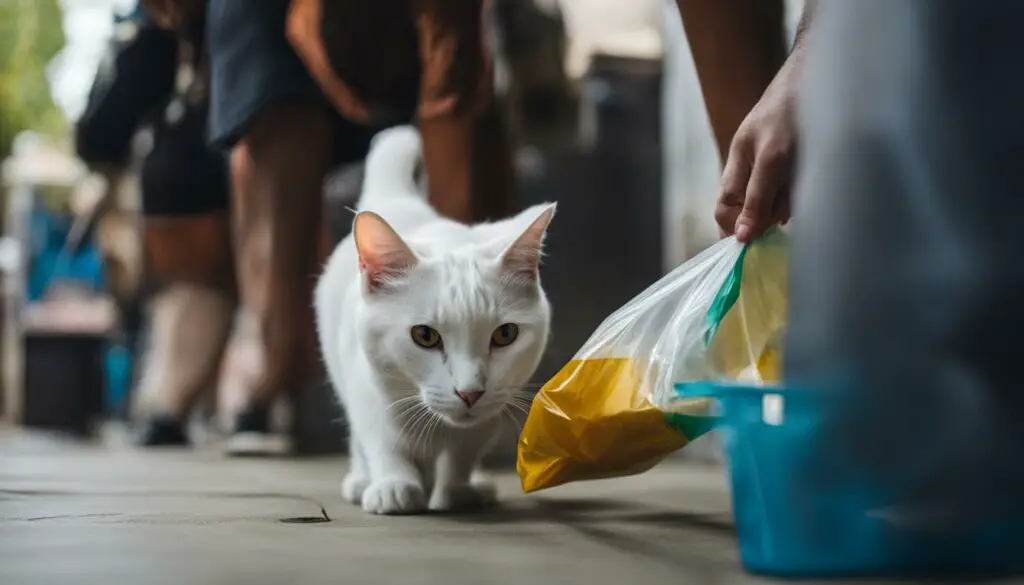
Table: Comparison of Preventative Measures for Cats with Plastic Licking Behavior
| Preventative Measures | Benefits |
|---|---|
| Creating a Stimulating Environment | Reduces boredom and stress, provides mental and physical stimulation |
| Nutrition and Health Maintenance | Addresses underlying health issues, ensures proper diet and nutrition |
| Removing Access to Plastic Objects | Prevents cats from engaging in plastic licking behavior |
Seeking Veterinary Advice for Cats with Plastic Licking Behavior
If your cat continues to exhibit plastic licking behavior despite your best efforts in prevention, it is important to seek veterinary advice. A veterinarian can assess your cat’s overall health and address any underlying medical issues that may be contributing to this behavior. By consulting a professional, you can take the necessary steps to ensure your cat’s safety and well-being.
During the veterinary visit, the veterinarian will conduct a thorough examination of your cat. They may perform a physical examination, conduct a fecal test, and recommend additional laboratory tests to identify any underlying health conditions that may be causing or exacerbating the plastic licking behavior.
Based on the veterinarian’s evaluation, they may recommend a specific diet or medication that can help manage the behavior. In some cases, a referral to a veterinary behaviorist, who specializes in animal behavior, may be necessary for further evaluation and treatment. It is important to follow the guidance of the veterinarian and work closely with them to address the plastic licking behavior.
“Seeking veterinary advice is crucial to identify and address any underlying health issues contributing to the plastic licking behavior.”
Remember, seeking veterinary advice is essential in providing your cat with the best possible care. The veterinarian’s expertise and experience will help ensure that your cat’s medical needs are met and that any contributing factors to the plastic licking behavior are addressed. By working together with your veterinarian, you can find the most effective strategies to keep your cat safe and healthy.
What the experts say:
“The veterinary consultation allows for a comprehensive assessment of your cat’s health and behavior, leading to tailored treatment options for the plastic licking behavior.” – Dr. Amanda Smith, DVM
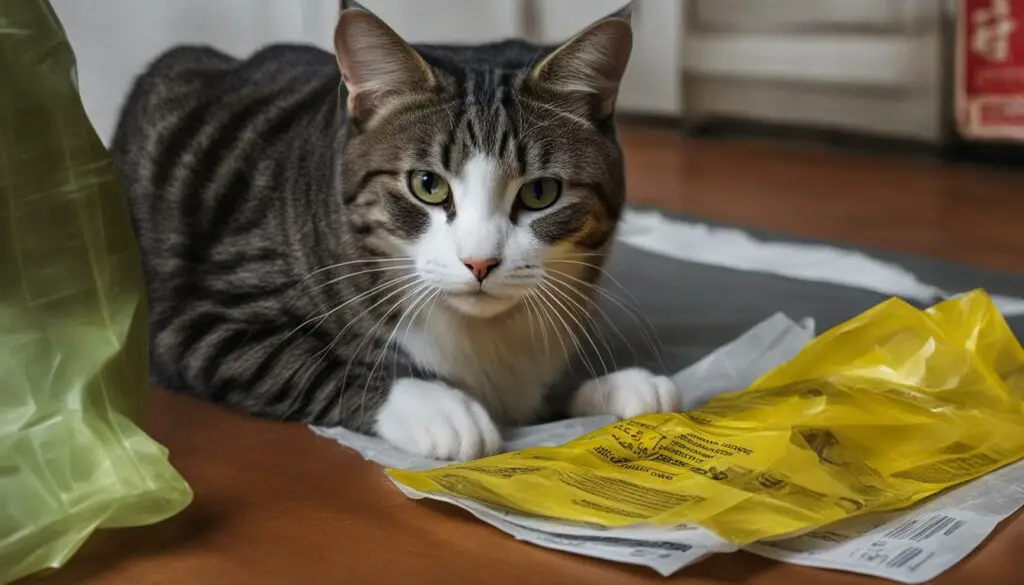
Enriching Your Cat’s Environment to Prevent Plastic Licking
Cats are curious creatures with a natural inclination to explore and engage with their surroundings. To prevent plastic licking behavior in cats, it is essential to provide them with a stimulating environment that satisfies their instinctual needs. By incorporating a variety of enriching elements, you can redirect their attention away from plastic and promote healthier behaviors.
One effective way to enrich your cat’s environment is by offering a wide range of toys. Interactive toys such as puzzle feeders or treat-dispensing toys can provide mental stimulation and encourage natural hunting behaviors. Solo play toys like balls, stuffed mice, or feather wands can keep them engaged and entertained when you’re not available to play with them.
Cat grass and catnip are also excellent alternatives to plastic that can help satisfy your cat’s desire to chew. Cat grass provides essential nutrients and aids in digestion, while catnip can stimulate their senses and provide a euphoric effect. These natural options can redirect their focus away from plastic and offer a safe and enjoyable chewing experience.
| Enriching Your Cat’s Environment | Benefits |
|---|---|
| Provide a variety of toys | Stimulates mental and physical engagement |
| Offer cat grass and catnip | Satisfies chewing instincts and provides sensory stimulation |
Creating vertical spaces, hiding spots, and scratching posts can also enhance your cat’s environment. Cats love to climb, explore elevated areas, and have their own safe spaces to retreat to. By providing vertical spaces like cat trees or shelves, you can satisfy their natural instinct to perch and observe their surroundings. Hiding spots such as cozy beds or cardboard boxes offer a sense of security and privacy. Additionally, scratching posts or boards can help fulfill their need to scratch and mark their territory.
Remember, every cat is unique, so it’s important to observe their preferences and adjust their environment accordingly. By providing a stimulating and enriching environment, you can help prevent plastic licking behavior and ensure your cat’s overall well-being.

Removing Temptations and Ensuring Safety
As responsible cat owners, it is crucial to take proactive measures to remove temptations and ensure the safety of our feline friends. Cats are curious creatures, and their affinity for plastic objects can put them at risk. By following a few simple steps, we can create a safe environment for our cats and minimize the hazards associated with plastic licking.
Storing Plastic Bags and Closing Doors
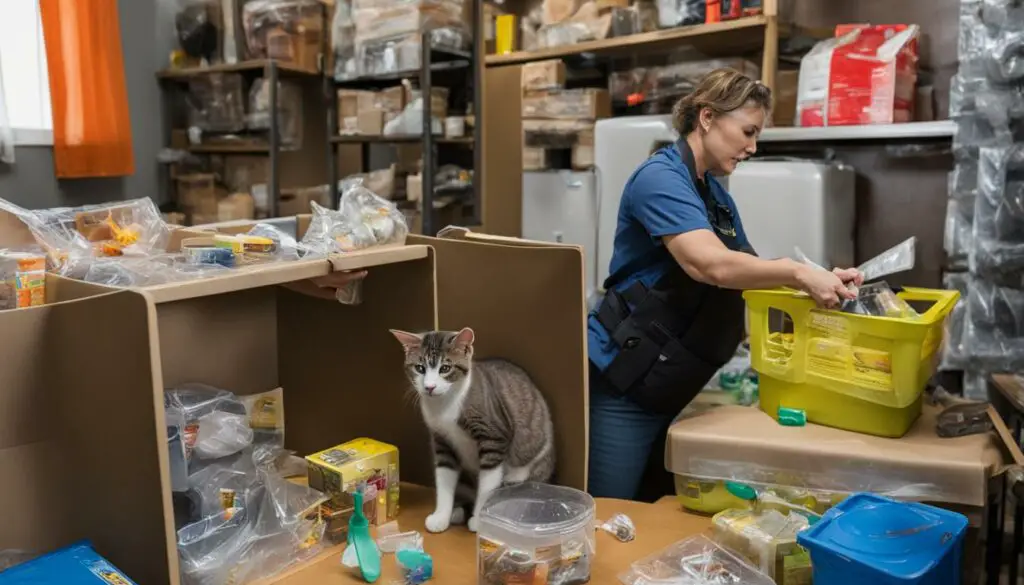 One of the first steps is to store plastic bags securely out of reach. Cats are known to be attracted to the crinkly sound and texture of plastic. Storing bags in sealed containers or cabinets can prevent cats from accessing them. Additionally, make sure to close doors to rooms that contain plastic-coated cords, such as electrical appliance areas or home offices. This will limit your cat’s access to potentially dangerous chewing opportunities.
One of the first steps is to store plastic bags securely out of reach. Cats are known to be attracted to the crinkly sound and texture of plastic. Storing bags in sealed containers or cabinets can prevent cats from accessing them. Additionally, make sure to close doors to rooms that contain plastic-coated cords, such as electrical appliance areas or home offices. This will limit your cat’s access to potentially dangerous chewing opportunities.
Confine Cats and Provide Safe Alternatives
Another way to protect cats from the hazards of plastic is to confine them to a safe room when unsupervised. This room should be free from plastic and other potentially harmful objects. Providing your cat with safe alternatives to chew on can redirect their attention. Look for non-toxic chew toys that are specifically designed for cats. These toys can help satisfy their chewing instincts in a safe and controlled manner.
Bitter-Tasting Sprays as a Deterrent
If your cat continues to show interest in chewing on plastic objects, a bitter-tasting spray can be used as a deterrent. These sprays are designed to have an unpleasant taste, discouraging cats from chewing on the sprayed objects. However, it is important to note that bitter-tasting sprays should be used in combination with other preventative measures, such as providing a stimulating environment and safe alternatives to plastic.
By implementing these preventative measures, we can minimize the risks associated with cats licking plastic. Removing temptations, providing safe alternatives, and creating a safe environment will help ensure the well-being and safety of our furry companions.
The Importance of Regular Veterinary Check-ups
As cat owners, it is vital to prioritize the health and well-being of our feline companions. Regular veterinary check-ups play a crucial role in ensuring the overall health and longevity of our cats. These check-ups provide an opportunity for a professional assessment of their health, early detection of any potential issues, and necessary preventive care.
During a veterinary check-up, your cat’s veterinarian will perform a thorough physical examination, which may include checking their vital signs, examining their coat and skin, listening to their heart and lungs, and assessing their overall body condition. These examinations help identify any signs of illness or underlying health conditions that may not be visible to the naked eye.
Additionally, regular veterinary check-ups allow for important preventive measures to be taken. This may include vaccinations to protect against common feline diseases, deworming to prevent or eliminate parasites, and routine screenings such as bloodwork or fecal tests to detect any underlying health issues before they progress.
By being proactive with veterinary check-ups, cat owners can ensure that any potential health concerns are addressed promptly, increasing the likelihood of successful treatment and minimizing the risk of more serious complications. Regular veterinary care is an important part of responsible cat ownership and contributes to the overall well-being and longevity of our beloved feline friends.
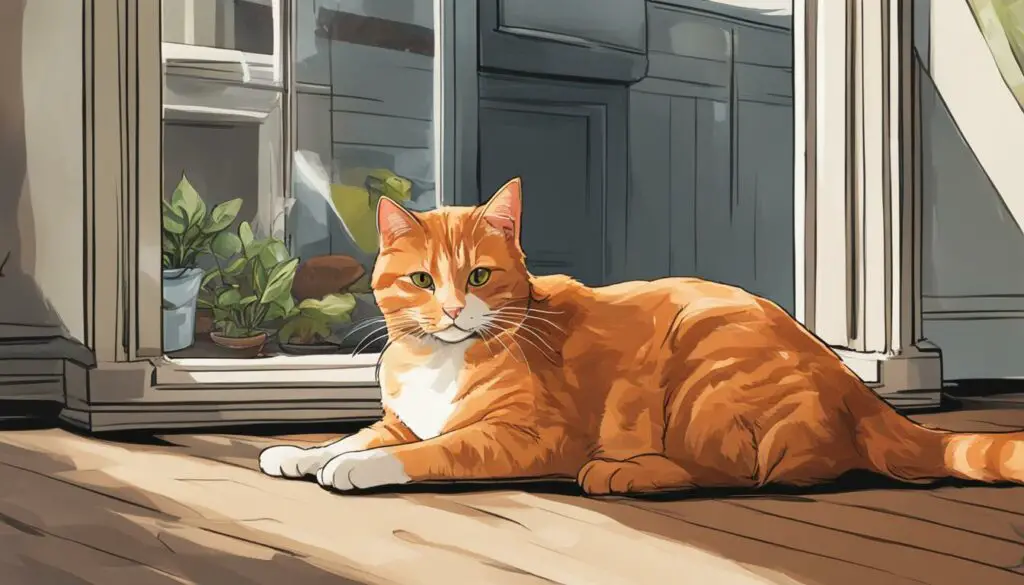
The Benefits of Regular Veterinary Check-ups for Cats:
- Early detection and treatment of any underlying health issues
- Prevention of common feline diseases through vaccinations
- Identification and control of parasites through deworming
- Routine screenings to monitor organ function and overall health
- Professional advice and guidance on cat care and nutrition
- Opportunity to discuss any behavior concerns or changes
Conclusion
Regular veterinary check-ups are essential for maintaining the health and well-being of our cats. By scheduling routine visits with a trusted veterinarian, cat owners can ensure that their feline companions receive the necessary care and attention they need. Early detection of any potential health issues, preventive measures, and professional guidance are all key benefits of regular veterinary check-ups. Remember, a healthy cat is a happy cat!
Understanding Cat Behavior and Communication
When it comes to our feline friends, decoding their behavior and communication can be a fascinating endeavor. Cats have their own unique ways of expressing themselves, and by understanding these behaviors, we can deepen our bond with our furry companions.
One example of cat behavior that may seem unconventional is licking plastic. While it might be easy to dismiss this behavior as odd or nonsensical, there could be underlying reasons behind it. Some cats may be drawn to the taste or texture of plastic bags, while others may be mimicking hunting sounds. By recognizing these motives, we can better understand our cats’ desires and preferences.
Cats communicate not only through their actions but also through their body language. Tail wagging, exposing their tummy, and kneading are all ways cats express their emotions and comfort levels. Paying attention to these cues allows us to respond appropriately and create a safe and nurturing environment for our cats.
Overall, understanding cat behavior and communication is key to building a strong relationship with our pets. By observing their actions, decoding their behaviors, and responding appropriately, we can ensure their happiness and well-being. So the next time you see your cat licking plastic or exhibiting any other quirks, take a moment to decode their message and strengthen the bond between you.

Decoding Feline Behavior: A Quick Guide
- Closed eyes while being petted: Indicates comfort and trust.
- Kneading: Shows happiness and contentment.
- Knocking things over: Could be a way to seek attention or engage in play.
- Preference for grass and plants: Driven by nutritional instincts and the need for mental stimulation.
| Behavior | Meaning |
|---|---|
| Closed eyes while being petted | Indicates comfort and trust |
| Kneading | Shows happiness and contentment |
| Knocking things over | Could be a way to seek attention or engage in play |
| Preference for grass and plants | Driven by nutritional instincts and the need for mental stimulation |
Quirky Cat Behaviors Decoded
As cat owners, we often find ourselves amused and intrigued by the unique behaviors displayed by our feline friends. From their playful antics to their mysterious habits, cats have a way of keeping us on our toes. In this section, I will delve into some of the most common quirky cat behaviors and decode their meanings, allowing you to better understand and connect with your furry companion.
1. Kneading:
One behavior that many cat owners are familiar with is kneading. This is when your cat presses their paws rhythmically against a soft surface, such as your lap or a blanket. Kneading is a throwback to their kittenhood when they would knead their mother’s belly to stimulate milk flow. It is a sign of contentment and relaxation, indicating that your cat feels safe and comfortable in your presence.
2. Chattering:
Have you ever noticed your cat sitting by the window, staring intensely at birds or squirrels? You may have also heard them emit a strange chattering noise. This behavior is thought to be a hunting instinct, as cats mimic the sound of their prey. It is their way of expressing excitement and frustration at being unable to pounce on their desired target. So the next time you hear your cat chattering, know that they are simply showing their predatory instincts.
| Common Cat Behaviors Decoded | |
|---|---|
| Behavior | Meaning |
| Kneading | Contentment and relaxation |
| Chattering | Excitement and frustration |
| Pawing at Water | Curiosity and playfulness |
| Tail Twitching | Agitation or arousal |
3. Pawing at Water:
If you’ve ever witnessed your cat pawing at their water bowl or splashing water around, don’t be alarmed. This behavior is often seen in cats who have an innate curiosity and enjoy exploring their surroundings. It can also be a playful behavior as they watch the ripples and movement of the water. Providing a shallow dish of water or a water fountain may satisfy their curiosity and prevent them from making a mess.
4. Tail Twitching:
Cats communicate their emotions and intentions through their tails. A tail twitching or wagging rapidly from side to side is often a sign of agitation or arousal. It can indicate that your cat is feeling excited, anxious, or agitated. Pay attention to the context in which this behavior occurs, as it may help you better understand your cat’s mood and respond accordingly.
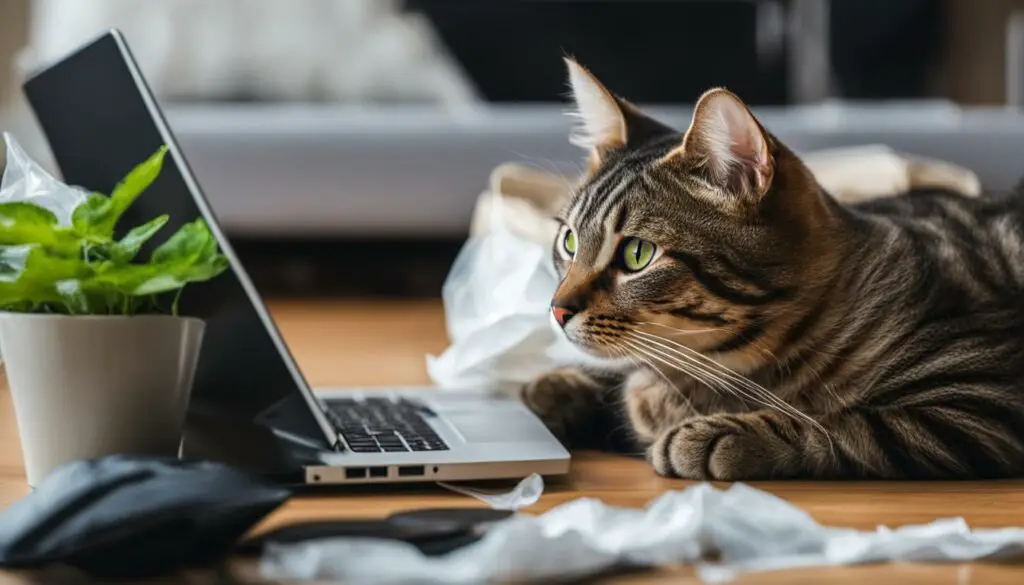
Understanding these quirky cat behaviors can enhance the bond between you and your feline companion. By decoding their actions, you can gain insights into their emotions and needs, allowing you to provide a nurturing and enriching environment. Remember, every cat is unique, so take the time to observe and learn from your cat’s behavior, and cherish the delightful and sometimes puzzling moments they bring into your life.
The Power of Bonding with Your Cat
Building a strong bond with your cat is not only a rewarding experience but also essential for their overall well-being. Cats are intricate creatures with unique personalities, and by understanding their behaviors and needs, you can deepen your relationship with them. Here are some tips to help you strengthen the bond with your feline friend:
- Create a Safe and Comfortable Environment: Providing a safe and comfortable environment is crucial for your cat to feel secure and at ease. Ensure they have a cozy bed, scratching posts, and plenty of hiding spots where they can retreat when they need some alone time.
- Engage in Playtime: Cats love to play, and interactive play sessions are an excellent way to bond with them. Use toys that mimic prey, such as feather wands or laser pointers, to engage their natural hunting instincts. Playing together not only strengthens your bond but also provides mental and physical stimulation for your cat.
- Offer Affection and Attention: Cats may have different preferences when it comes to affection, so observe your cat’s body language and respect their boundaries. Some cats enjoy being petted and cuddled, while others prefer being near you without physical contact. Pay attention to their cues and provide affection in a way that makes them feel comfortable and loved.
Remember, it takes time and patience to build a strong bond with your cat. Be consistent in your interactions, and always approach them with love and understanding. By nurturing this bond, you will create a lifelong connection with your feline companion.
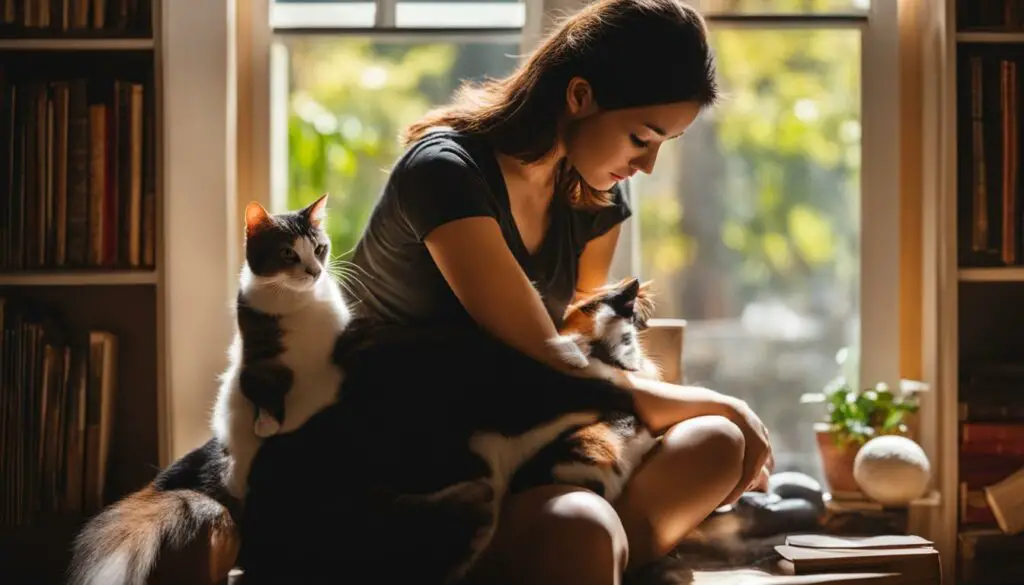
The Joys of Being a Cat Owner
Being a cat owner brings endless joy and fulfillment to my life. The love and companionship that my feline friend provides are truly priceless. Cats have a unique way of making you feel loved and appreciated, whether it’s through their gentle purring or their playful antics. Owning a cat has numerous benefits that enhance both your physical and mental well-being.
One of the greatest joys of cat ownership is the bond that develops between you and your furry companion. Cats have a way of understanding your emotions and offering comfort during difficult times. Whether you’re feeling stressed, lonely, or simply in need of company, your cat will be there to provide unconditional love and support.
Not only do cats offer emotional support, but they also bring a sense of calm and relaxation to your home. Their soothing purrs and gentle presence create a peaceful environment that can help reduce stress and anxiety. Studies have shown that spending time with a cat can lower blood pressure and contribute to overall heart health.
| Benefits of Owning a Cat |
|---|
| Companionship |
| Having a cat by your side provides a constant source of companionship and love. |
| Stress Relief |
| The presence of a cat has a calming effect, helping to reduce stress and anxiety. |
| Improved Heart Health |
| Studies have shown that interactions with cats can lower blood pressure and reduce the risk of heart disease. |
| Entertainment |
| Cats are natural entertainers, providing endless amusement with their playful behavior. |
| Mental Stimulation |
| Caring for a cat stimulates your mind and promotes mental well-being. |
“The love and companionship that my feline friend provides are truly priceless.”
Having a cat also brings a sense of purpose and responsibility. Taking care of another living being can be rewarding and fulfilling. From feeding and grooming to providing a safe and enriching environment, being a responsible cat owner allows you to make a positive impact on your pet’s life.
In conclusion, the joys of being a cat owner are immeasurable. The unconditional love, companionship, and health benefits that cats provide make them incredible additions to any household. The bond between a cat and its owner is truly special and brings endless happiness. So, if you’re considering getting a pet, I highly recommend opening your heart and home to a furry feline friend.
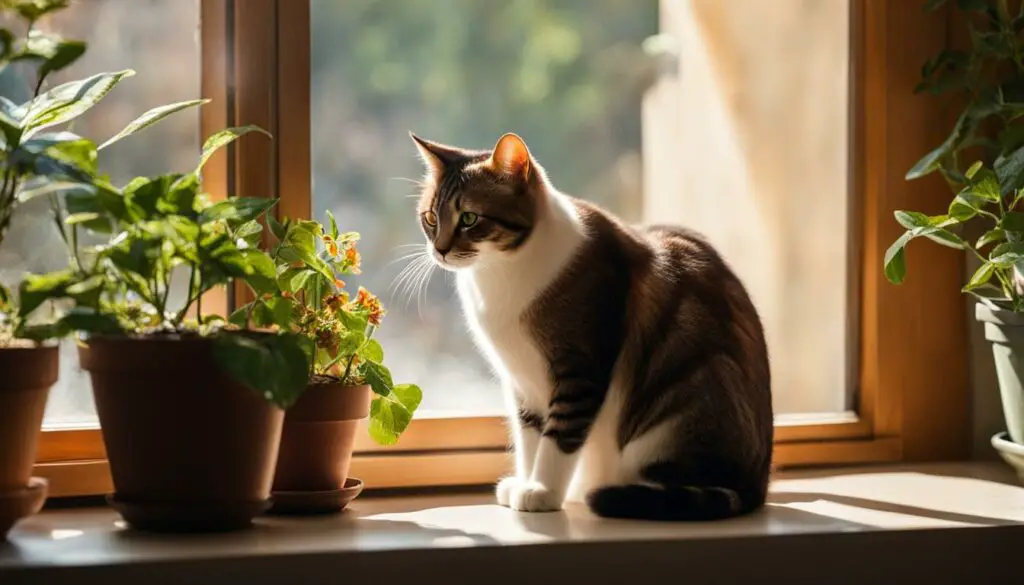
The Role of a Pet Expert
As a pet expert, I am dedicated to ensuring the well-being of cats and educating cat owners about responsible pet ownership. My role involves providing valuable guidance on various aspects of cat behavior and needs, including addressing the issue of cats licking plastic. By sharing my expertise, I aim to help cat owners create a safe and enriching environment for their feline companions.
Being a responsible cat owner involves understanding the risks associated with plastic licking behavior and taking preventative measures to keep cats safe. I emphasize the importance of regular veterinary check-ups to monitor the cat’s overall health and address any underlying medical issues contributing to this behavior. By engaging in open and proactive communication with a veterinarian, cat owners can ensure timely intervention and appropriate treatment.
One of my key roles as a pet expert is to guide cat owners on enriching their cat’s environment. Providing a stimulating and engaging environment can help prevent boredom, stress, and the likelihood of cats engaging in destructive behaviors like plastic licking. I recommend offering a variety of toys, vertical spaces, and scratching posts to keep cats mentally and physically stimulated. Additionally, safe alternatives to plastic, such as cat grass or catnip, can redirect their desire to chew.
“As a pet expert, my mission is to educate cat owners about the needs and behaviors of their pets, helping them provide the best care possible. By combining knowledge, experience, and a deep passion for animals, I strive to empower cat owners to be responsible and attentive caregivers.”
Table: Preventative Measures for Cats Licking Plastic
| Preventative Measures | Description |
|---|---|
| 1. Provide a stimulating environment | Offer a variety of toys, playtime, and vertical spaces to keep cats mentally and physically engaged, reducing the likelihood of them engaging in pica behaviors like plastic licking. |
| 2. Ensure proper nutrition | A well-balanced diet can help address any nutritional deficiencies that may contribute to pica behaviors. Consult a veterinarian for guidance on appropriate cat food. |
| 3. Address underlying health issues | If a cat continues to engage in plastic licking despite preventative measures, consult a veterinarian to identify and address any underlying health conditions that may be contributing to this behavior. |
| 4. Remove access to plastic | Store plastic bags out of reach, secure plastic wires, and remove any stray plastic objects from the cat’s environment to minimize temptation. |
| 5. Provide safe alternatives | Offer safe alternatives to plastic, such as cat grass or catnip, to redirect the cat’s desire to chew. |
By following these preventative measures and seeking professional guidance when needed, cat owners can play an active role in their pet’s health and happiness. As a pet expert, I am here to support cat owners in their journey to being responsible and attentive caregivers, ensuring a fulfilling and loving relationship with their feline companions.
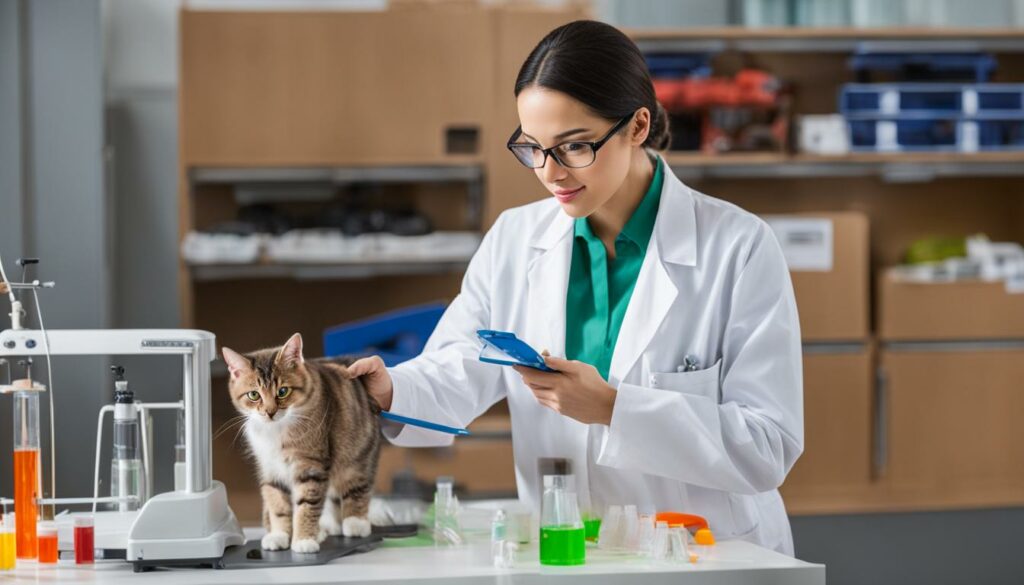
Conclusion
In conclusion, understanding and decoding cat behavior, including their tendency to lick plastic, is crucial for cat owners. It is important to recognize that plastic ingestion can pose significant risks to a cat’s health, such as intestinal blockage or the need for emergency surgery.
By identifying the causes of pica, the act of eating non-food items like plastic, cat owners can take preventative measures to discourage this behavior. Providing a stimulating and enriched environment, offering safe alternatives to plastic, and addressing any underlying health issues are effective ways to mitigate the risk of plastic licking.
Regular veterinary check-ups play a vital role in monitoring a cat’s overall health and addressing any concerns related to plastic licking. Veterinarians can provide appropriate guidance, recommend specific diets, and offer further evaluation and treatment if necessary.
Lastly, building a bond with your cat is an essential aspect of pet ownership. By understanding their unique behaviors and meeting their needs, cat owners can develop a deeper connection with their feline companion, creating a fulfilling and enriching relationship.
FAQ
Is it safe for cats to lick plastic?
No, cats should not lick plastic as it can pose serious health risks such as intestinal blockage or the need for emergency surgery.
What is pica in cats?
Pica is the act of eating non-food items, including plastic. It can be influenced by genetic factors, health issues, and environmental factors.
Which cat breeds are more prone to developing pica?
Certain cat breeds, such as Siamese and Burmese, are predisposed to developing pica.
What are the risks of cats licking plastic?
Cats that lick plastic face risks such as intestinal blockage, burns or electrocution from chewing on plastic wires, and choking hazards or gastrointestinal obstructions from swallowing plastic objects.
How can I prevent my cat from licking plastic?
Providing a stimulating and enriched environment, addressing any underlying health issues, and removing access to plastic objects can help discourage cats from engaging in plastic licking behavior.
Should I consult a veterinarian if my cat continues to lick plastic?
Yes, it is advisable to consult a veterinarian who can assess your cat’s overall health and address any underlying medical issues contributing to the behavior.
How can I create a stimulating environment for my cat?
Offering a variety of toys, providing vertical spaces and hiding spots, and engaging in playtime can help create a stimulating environment for your cat.
How can I remove temptations and ensure my cat’s safety?
Storing plastic bags out of reach, closing doors to rooms with plastic-coated cords, and confining the cat to a safe room when unsupervised can help prevent plastic licking and ensure their safety.
Why are regular veterinary check-ups important?
Regular veterinary check-ups allow for monitoring your cat’s overall health, addressing any concerns, and early intervention and treatment if needed.
How can I better understand my cat’s behavior and communication?
Understanding cat behavior and communication cues such as closing their eyes when being petted, kneading, and tail wagging can help you decipher your cat’s actions and emotions.
What are some common cat behaviors and their meanings?
Closing their eyes when being petted indicates comfort and trust, kneading expresses happiness and contentment, knocking things over seeks attention or play, and preference for grass and plants may be driven by nutritional instincts and the need for mental stimulation.
How can I bond with my cat?
Taking the time to play, interact, and meet your cat’s physical and mental needs strengthens the bond between you and your feline friend.
What are the joys of being a cat owner?
Owning a cat brings companionship, comfort, and unconditional love. Embracing their unique behaviors and personality adds to the joys of cat ownership.
What is the role of a pet expert?
Pet experts educate cat owners about cat behaviors and needs, ensuring responsible and attentive care. Their guidance contributes to the overall health and happiness of cats and their owners.
Is it safe for cats to lick plastic?
No, cats should not lick plastic due to the potential health risks associated with plastic ingestion.
Source Links
- https://yourpetandyou.elanco.com/us/behavior/how-to-decode-weird-cat-behaviors
- https://www.petplay.com/blogs/tips/decoding-your-cats-behavior-9-things-you-should-know
- https://www.dailypaws.com/cats-kittens/behavior/common-cat-behaviors/why-do-cats-eat-plastic

